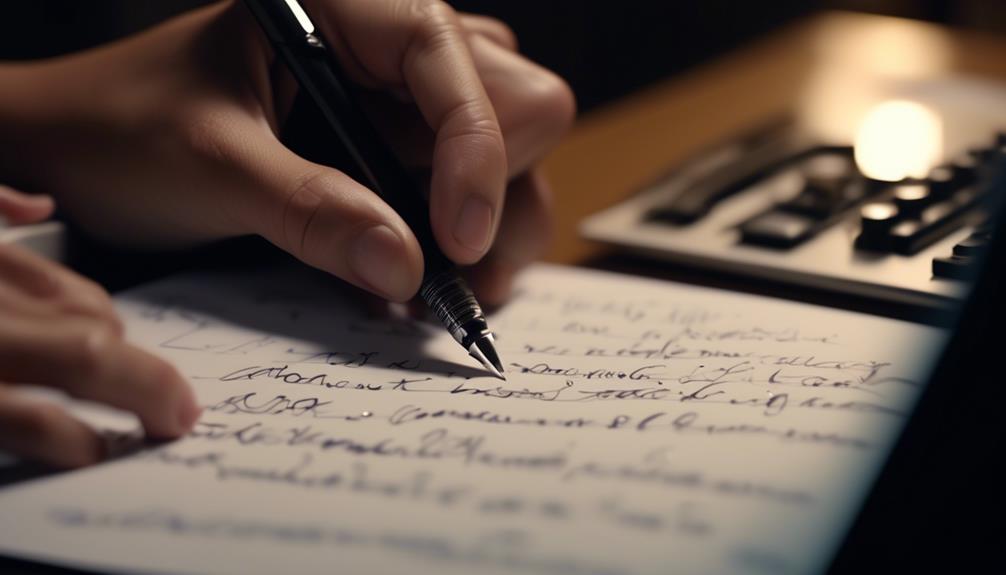In the world of handwritten data entry, you are like a detective deciphering clues from cryptic scripts to uncover valuable information. However, this task demands more than just a keen eye and nimble fingers. There are ten essential skills that can elevate your performance in this intricate dance of transcribing handwritten content into digital form. Each skill is a key that unlocks a different aspect of this challenging yet rewarding process. So, are you ready to unlock the secrets to mastering handwritten data entry?
Fast Typing Speed
To increase your typing speed, practice consistently and focus on improving your accuracy. Utilizing proper typing techniques is essential for enhancing your speed. Ensure your fingers are correctly positioned on the home row keys and use all ten fingers to type efficiently. Avoid looking at the keyboard and instead, focus on the screen to build muscle memory and increase your speed.
Speed drills are an effective way to boost your typing speed. Set aside dedicated time for speed drills each day to challenge yourself and monitor your progress. Start with simple exercises and gradually increase the difficulty as you improve. Timing yourself during these drills can help track your speed improvements over time.
High Accuracy
Improving your typing accuracy is crucial for handwritten data entry, as it complements your speed and ensures precise input. To enhance your accuracy, consider the following key points:
- Error Prevention
- Double-check entries before finalizing them to catch any mistakes.
- Utilize tools like spell check and grammar check to reduce errors.
- Regularly update your knowledge and skills to minimize the chances of making errors.
High accuracy in handwritten data entry is essential for maintaining quality control. By focusing on error prevention, you can ensure that the data you input is correct and reliable. Quality control goes beyond just speed; it involves meticulous attention to detail and a commitment to producing error-free work. By incorporating error prevention techniques and maintaining a focus on quality, you can elevate your handwritten data entry skills to a professional level.
Good Reading Skills
To excel in handwritten data entry, you must master the art of reading legible handwriting with precision. By understanding the context of the data you encounter, you can ensure accurate transcription and interpretation. These skills are crucial for maintaining efficiency and minimizing errors in data entry tasks.
Reading Legible Handwriting
Developing strong reading skills is crucial for accurately deciphering handwritten data entries. To enhance your ability to read legible handwriting effectively, consider the following:
- Handwriting analysis:
- Pay attention to letter formations and common patterns to become more adept at recognizing different writing styles.
- Practice comparing similar letters or words to improve your speed and accuracy in reading various scripts.
- Familiarize yourself with different writing conventions to better understand diverse writing systems and styles.
Understanding Data Context
Enhance your ability to decipher handwritten data entries by understanding the context in which the data is presented. Utilize data interpretation techniques and contextual understanding to extract valuable information effectively. By honing your handwriting analysis skills, you can identify patterns, variations, and specific characteristics that aid in accurate data extraction. Pay attention to the layout of the document, the purpose of the information, and any accompanying details that provide clues to the data’s meaning. Practice associating certain handwriting styles with particular data types to streamline your interpretation process. Developing a keen sense of contextual understanding will significantly improve your efficiency in handwritten data entry tasks. Remember, mastering data extraction techniques through contextual awareness is key to successful handwritten data interpretation.
Patience
How can maintaining a calm and steady demeanor benefit your handwritten data entry process? Patience is a key attribute that can significantly enhance your efficiency and accuracy in handwritten data entry. Here’s why:
- Patience Training: Engaging in patience training exercises can help you develop the ability to stay focused and composed even during tedious data entry tasks. This training can improve your overall productivity and reduce errors caused by rushing through entries.
- Handwriting Analysis: Taking the time to analyze your own handwriting patterns and tendencies requires patience. By understanding your unique writing style, you can adapt your data entry techniques to ensure consistency and readability. This attention to detail can prevent misunderstandings and data misinterpretation.
- Error Prevention: Patience plays a crucial role in error prevention. Rushing through data entry can lead to mistakes that may be time-consuming to rectify. By maintaining a patient approach, you can catch and correct errors before they escalate, ultimately saving time and effort in the long run.
Concentration
Maintaining a calm and steady demeanor during handwritten data entry not only relies on patience but also hinges on your ability to concentrate effectively. To enhance your concentration skills, it is crucial to employ focus techniques and mindfulness strategies. When faced with a large amount of data to transcribe, try breaking the task into smaller, manageable sections. This allows you to focus on one portion at a time, reducing the likelihood of distractions creeping in. Additionally, practice mindfulness by bringing your awareness to the present moment. Take deep breaths, center yourself, and eliminate any external disruptions. Engaging in short meditation sessions before beginning your data entry work can also help sharpen your focus.
Furthermore, establish a conducive work environment free from clutter and noise to aid in concentration. Minimize interruptions by silencing notifications and setting designated work hours. Remember, honing your concentration skills is a gradual process, so be patient with yourself as you implement these focus techniques and mindfulness strategies into your handwritten data entry routine.
Familiarity With Data Entry Software
You should be well-versed in data entry tools and software skills to excel in handwritten data entry tasks. Understanding how to navigate through data entry software efficiently will save you time and minimize errors. Mastering these skills is essential for a smooth and productive data entry process.
Data Entry Tools
It is crucial for data entry professionals to possess a strong familiarity with various data entry software tools to enhance their efficiency and accuracy in handling handwritten data. When it comes to data entry tools, consider the following:
- Data Validation Techniques: Utilize software features that help validate the accuracy and completeness of handwritten data entered.
- Perform real-time validation to catch errors promptly.
- Implement automated validation rules to ensure data integrity.
- Error Handling: Familiarize yourself with error handling functionalities within the software to effectively manage and correct mistakes during data entry.
- Understand how to track and resolve errors efficiently.
- Learn to use error logs and reports to identify patterns and prevent future mistakes.
Software Skills
Having a strong familiarity with data entry software tools is essential for you to efficiently handle handwritten data, including utilizing data validation techniques and error handling functionalities to ensure accuracy and integrity. Data validation techniques and accuracy checks are crucial in verifying the correctness of handwritten data input. Understanding user interface design and conducting usability testing can enhance the efficiency of data entry processes. By being adept at navigating data entry software, you can streamline the entry of handwritten information, minimize errors, and maintain data integrity. Familiarity with various software functionalities will enable you to work effectively with handwritten data, ensuring that the information entered is accurate and reliable.
Ability to Decipher Handwriting
Deciphering handwriting requires keen observation and attention to detail. When faced with handwritten text, your ability to accurately interpret the content is crucial for precise data entry. Here are some key points to enhance your handwriting deciphering skills:
- Handwriting analysis: Understanding different styles of handwriting can aid in deciphering challenging texts. Pay attention to letter formations, slant, and overall consistency to decode the content effectively.
- Recognize common handwriting patterns to streamline the interpretation process.
- Practice comparing and contrasting various handwritten samples to improve your analytical skills.
- Data interpretation: Extracting meaningful information from handwritten documents relies on your interpretation skills. Look beyond the words themselves and consider the context in which the text was written.
- Utilize your knowledge of the subject matter to fill in gaps and make educated guesses when deciphering ambiguous handwriting.
- Contextual clues: Surrounding context can provide valuable hints when deciphering handwriting. Take into account factors such as the time period, author’s background, and purpose of the text to enhance your understanding.
- Look for recurring phrases or keywords that may offer insights into the overall message of the handwritten content.
Basic Computer Skills
To excel in handwritten data entry, you must master keyboard proficiency, ensuring swift and accurate input. Familiarity with essential software programs is crucial for organizing and managing data efficiently. Regular practice to enhance data accuracy is key to successful data entry tasks.
Keyboard Proficiency
Improving your keyboard proficiency is fundamental for mastering basic computer skills. To enhance your abilities in this area, focus on the following key aspects:
- Typing Techniques
- Practice proper hand placement on the keyboard to increase speed and accuracy.
- Work on touch typing to minimize errors and improve efficiency.
- Learn to utilize all fingers for typing to optimize your performance.
Software Familiarity
Enhancing your proficiency with various software programs is essential for developing basic computer skills. When it comes to handwritten data entry, understanding data entry software features is crucial. These features may include auto-fill options, customizable templates, and data validation tools to ensure accuracy. Familiarizing yourself with these features can significantly improve your efficiency and accuracy in data entry tasks.
Moreover, mastering software integration techniques is equally important. Being able to seamlessly transfer data between different programs or platforms can streamline your workflow. Learning how to import and export data, as well as integrating data from various sources, can enhance your productivity when working with handwritten data entry. By honing these software skills, you can become a more proficient data entry specialist.
Data Accuracy Practice
Developing a keen eye for detail is crucial in honing your data accuracy skills in basic computer tasks.
- Data validation techniques
- Utilize validation rules to ensure accurate data input.
- Implement range checks to validate numerical entries.
- Error correction
- Regularly review and correct any identified errors promptly.
- Use error-checking functions provided by software tools.
- Data integrity checks
- Perform regular integrity checks to maintain data consistency.
- Utilize checksums or hash functions to verify data integrity.
- Quality assurance
- Establish quality control procedures to monitor data accuracy.
- Conduct periodic audits to ensure adherence to data accuracy standards.
Attention to Detail
To ensure accurate handwritten data entry, meticulous attention to detail is essential. Visual perception plays a crucial role in identifying patterns, recognizing characters, and distinguishing between similar symbols. When entering data by hand, you must rely on your visual acuity to accurately transcribe information. By paying close attention to the details of each character, number, or symbol, you can minimize errors and ensure the integrity of the data you input.
Error detection is another vital aspect of maintaining accuracy in handwritten data entry. Your ability to spot inconsistencies, irregularities, or discrepancies is key to identifying and correcting mistakes before they impact the data’s quality. This skill requires a sharp eye for detail and a commitment to reviewing your work carefully.
Good Organizational Skills
Having good organizational skills is crucial for successful handwritten data entry, as it helps streamline the process and maintain accuracy. When it comes to handwritten data entry, time management and task prioritization are key components of good organizational skills. Here’s how you can apply these skills effectively:
- Time Management
- Allocate specific time slots for data entry tasks to ensure steady progress.
- Use timers or alarms to stay on track and avoid spending too much time on a single entry.
- Break down larger tasks into smaller, manageable segments to prevent feeling overwhelmed.
- Task Prioritization
- Identify urgent entries that require immediate attention to prevent delays.
- Sort entries based on deadlines or importance to focus on critical data first.
- Create a structured workflow by organizing entries based on categories or data types.
Frequently Asked Questions
How Can I Improve My Handwriting to Make It Easier for Data Entry?
To enhance data entry legibility, practice handwriting exercises regularly. Focus on consistency, spacing, and clarity. Keep a steady pace and maintain proper posture. These efforts will make your handwriting clearer and more suitable for data entry tasks.
Are There Any Tips for Staying Focused and Maintaining Concentration During Long Data Entry Sessions?
To maintain focus during long data entry sessions, try using mindfulness techniques and concentration exercises. Manage your time wisely by scheduling breaks. Stay attentive and alert to improve productivity and accuracy in your work.
What Strategies Can I Use to Quickly Decipher Difficult or Messy Handwriting?
When faced with messy handwriting, focus on individual letters first. Use context clues, like surrounding words, to piece together the meaning. Practice deciphering different styles to improve efficiency in data entry. Remember, patience is key!
How Can I Prevent Errors and Maintain High Accuracy in My Data Entry Work?
To prevent errors and maintain high accuracy in data entry, focus on double-checking entries, developing a systematic approach, and improving handwriting legibility. Consistent practice and attention to detail will enhance your accuracy and efficiency.
What Are Some Common Pitfalls to Avoid When Organizing and Inputting Data?
To avoid common pitfalls in organizing and inputting data, focus on mastering data validation techniques for accuracy and efficient error handling. Embrace effective keyboard shortcuts and efficiency techniques to boost productivity and precision.




